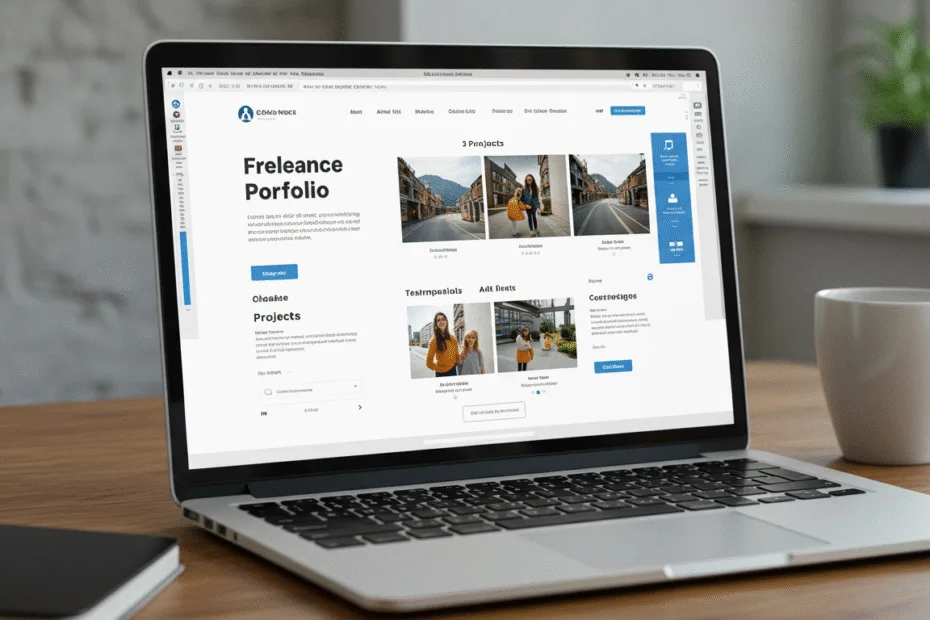How to Build a Freelance Portfolio That Attracts Clients. Learn how to build a freelance portfolio that showcases your skills, impresses clients, and boosts your credibility. Step-by-step guide included.
What is a Freelance Portfolio?
A freelance portfolio is a curated collection of your best work that demonstrates your skills, experience, and expertise to potential clients. Whether you’re a writer, designer, developer, or marketer, a strong portfolio builds trust, proves your value, and sets you apart from the competition.
In today’s digital world, having an online presence through a professional portfolio is no longer optional—it’s essential for success in freelancing.
Why You Need a Freelance Portfolio
1. Builds Credibility
A well-organized portfolio gives clients confidence in your abilities by showcasing real results from past projects.
2. Helps You Stand Out
With so many freelancers competing for the same jobs, your portfolio can be the deciding factor that makes a client choose you.
3. Simplifies the Hiring Process
Clients often prefer to see examples of your work rather than just reading a resume or list of skills.
4. Supports Your Pricing Strategy
High-quality samples of your work justify higher rates and help you avoid undercharging due to lack of proof.
How to Build a Freelance Portfolio: Step-by-Step Guide?
Step 1: Define Your Niche and Target Audience
Before building your portfolio, know what services you offer and who your ideal clients are. This helps tailor your content and presentation accordingly.
Step 2: Select Your Best Work
Choose 5–10 high-quality projects that represent your strengths. Focus on variety, relevance, and impact.
Step 3: Write Clear Project Descriptions
For each project, include:
- The problem or goal
- Your role and solution
- The result or outcome Use clear language and avoid jargon.
Step 4: Choose a Platform
Select a user-friendly platform to host your portfolio. Popular options include:
- WordPress
- Wix
- Squarespace
- Carrd
- Behance (for designers)
- Dribbble (for creatives)
Step 5: Add Testimonials and Reviews
Client testimonials add social proof. If you don’t have any yet, ask previous clients for feedback or offer a small incentive for a review.
Step 6: Include a Bio and Contact Page
Introduce yourself briefly, highlight your skills, and make it easy for clients to reach out via email or contact form.
Step 7: Optimize for SEO
Use relevant keywords like “freelance portfolio,” “graphic design portfolio,” or “content writing samples” depending on your niche. This increases visibility on search engines.
Freelance Portfolio Examples by Industry
| Industry | Key Elements to Include |
|---|---|
| Writing | Published articles, blog posts, editing samples |
| Graphic Design | Visual projects, branding examples, before/after visuals |
| Web Development | Code snippets, live websites, wireframes |
| Marketing | Campaign reports, analytics dashboards, strategy documents |
| Video Editing | Demo reels, short clips, client videos |
Common Mistakes to Avoid
- Using Low-Quality Samples: Only showcase your best work.
- Overloading with Too Many Projects: Keep it concise and focused.
- Ignoring Mobile Optimization: Ensure your portfolio looks good on all devices.
- Not Updating Regularly: Refresh your portfolio as you complete new projects.
- Lack of Call-to-Action: Encourage visitors to contact or hire you.
Tools to Help You Build a Freelance Portfolio
| Tool | Purpose |
|---|---|
| Canva | Designing visual elements |
| Adobe Portfolio | For creative professionals |
| GitHub | For developers to share code |
| Google Drive | To host downloadable PDF portfolios |
| Unsplash / Pexels | For royalty-free images |
How to Use Your Portfolio on Freelance Platforms?
Many platforms like Upwork, Fiverr, and Toptal allow you to upload a portfolio or link to your personal website. Make sure to:
- Tailor your profile to match your portfolio
- Link to your external site in your bio
- Upload sample files if allowed
- Update regularly based on performance

Building a Freelance Portfolio Without Experience
If you’re just starting out, here’s how to create a portfolio without prior work:
1. Do Practice Projects
Create mock projects based on real-world scenarios or redesign existing websites/apps.
2. Offer Free or Discounted Work
Volunteer to help non-profits or small businesses in exchange for permission to use the work in your portfolio.
3. Replicate Popular Designs
Design logos, landing pages, or UI elements similar to well-known brands to show your capabilities.
4. Take Courses with Capstone Projects
Platforms like Coursera, Udemy, and Skillshare offer courses that end with portfolio-worthy assignments.
Final Tips for a Winning Freelance Portfolio
- Keep your design clean and professional
- Focus on quality over quantity
- Highlight measurable outcomes
- Make it easy to navigate
- Include a downloadable version for offline sharing
Conclusion
Building a freelance portfolio is one of the most important steps in launching or growing your freelance career. It not only showcases your talent but also serves as a powerful marketing tool that attracts ideal clients and supports your growth.
By following the steps outlined in this guide, you’ll create a compelling portfolio that communicates your value, builds trust, and opens doors to new opportunities.
Final Thoughts
Whether you’re a seasoned freelancer or just getting started, your portfolio plays a crucial role in shaping your professional identity. By investing time into creating a polished, effective portfolio, you’ll set yourself up for long-term success in the competitive world of freelancing.
- Freelance portfolio examples, portfolio website builder, how to create a freelance portfolio, online portfolio for writers, digital portfolio tips
- Topic Clusters: Portfolio building, tools, SEO optimization, beginner strategies, industry-specific advice
- Natural Language: Conversational and informative tone
- Schema Markup Ready
Read This Article: Freelancing! Guide to Working Independently

